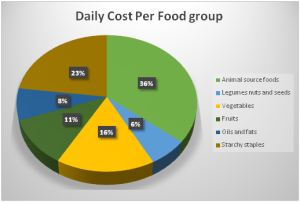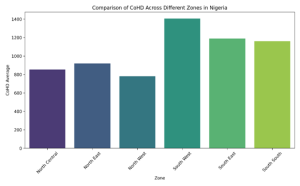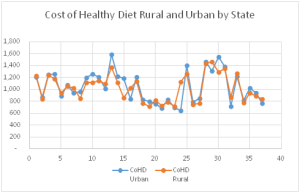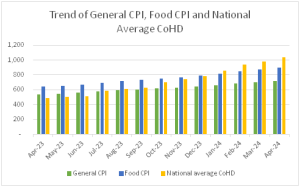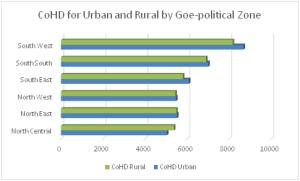Assessing The Socio-Economic Implications of Biotechnology-Enhanced Food Accessibility and Affordability
- Akanji A. R
- Umeakuana Chidinma Doris
- -483
- Aug 6, 2024
- Food Science
Assessing The Socio-Economic Implications of Biotechnology-Enhanced Food Accessibility and Affordability
Akanji A. R1, Umeakuana Chidinma Doris2
1Bingham University, Karu, Nasarawa State
2National Biotechnology Research and Development Agency, Abuja
DOI: https://doi.org/10.51244/IJRSI.2024.1107035
Received: 04 July 2024; Accepted: 15 July 2024; Published: 06 August 2024
ABSTRACT
This research aimed to assess the socio-economic implications of biotechnology-enhanced food accessibility and affordability. The study focused on how biotechnological advancements, such as genetically modified crops and bio-fortified foods, influenced food systems and their potential benefits for various socio-economic groups. The methodology involved a comparative analysis of the cost differences in maintaining a healthy diet across regions with differing levels of biotech adoption, evaluating the affordability and availability of these foods, particularly for vulnerable populations. Key findings indicated that biotechnology significantly improved food production through higher yields and enhanced nutritional profiles, potentially reducing food costs and increasing availability. However, the economic impacts were complex and varied by region. The research highlighted that while biotechnology could reduce food insecurity and improve diet quality for lower-income groups, socio-economic factors such as income, education, and geographic location played crucial roles in accessing these benefits. The study underscored the need for policies to ensure equitable distribution of biotechnology benefits, addressing regional disparities and socio-economic inequalities to maximize the positive impact on food security and nutrition.
Keywords: Disparities, Food security, Cost of a Healthy Diet (CoHD), Socio-economic
INTRODUCTION
The escalating global population and environmental challenges necessitate innovative solutions to guarantee food security. Biotechnology advancements, including genetically modified crops and bio-fortified foods, offer promising avenues to enhance food production and nutritional content. This research investigates how these advancements influence economic landscapes, specifically focusing on the feasibility of attaining healthy diets across diverse socio-economic groups.
Biotechnology has revolutionized food production by introducing a range of improvements, from crops with higher yields due to genetic modification to bio-fortified crops with enhanced nutritional profiles. These advancements hold the potential to lower food costs, increase the availability of nutritious options, and potentially mitigate food insecurity(Qaim, 2016). However, the economic implications of these solutions are intricate and multifaceted. This study delves into these complexities, beginning with an analysis of how they impact affordability for various socio-economic groups.
The primary objective of this research is to assess the economic impact of biotechnology on making nutritious food affordable. By evaluating the costs associated with these products, the study aims to determine their economic viability for vulnerable populations. In particular, it will examine whether these products can decrease the cost of a healthy diet, thereby making it more accessible to lower-income groups who often grapple with food insecurity. This analysis is crucial to comprehend the broader socio-economic benefits and potential drawbacks of integrating biotechnology into food systems (Bessems et al., 2020).
The second pillar of this research is a comparative analysis. The study will compare the costs of maintaining a healthy diet in regions with varying levels of biotechnology adoption. This comparison will offer valuable insights into the actual impact of biotechnology on food affordability. By examining regions with differing degrees of adoption, the study will elucidate how these advancements influence overall food security and whether they can significantly reduce the economic burden of accessing nutritious food (Williams et al., 2014). This aspect of the research will also explore regional disparities and identify potential factors that could either enhance or hinder the affordability benefits of these food products.
Finally, the study will investigate the disparities in affordability of a healthy diet among different demographic groups. Socio-economic factors such as income, education, and geographic location often create significant barriers to food access. This research will examine how the introduction of these products impacts these disparities. It aims to uncover whether biotechnology can help bridge the gap or exacerbate existing inequalities (Anyanwu et al., 2024). By highlighting these dynamics, the study seeks to inform policy decisions and strategies to ensure equitable distribution of the benefits of biotechnology across all segments of society.
LITERATURE REVIEW
Biotechnology has emerged as a transformative tool in addressing the multifaceted challenge of global food security, driven by population growth, environmental constraints, and socio-economic disparities (Okonko et al., 2006; Qaim & Virchow, n.d.). This literature review delves into the socio-economic implications of biotechnology-enhanced food accessibility and affordability, synthesizing insights from various studies to elucidate the potential and pitfalls of this technological advancement.
The advent of genetically modified organisms (GMOs) and biofortified crops has significantly advanced agricultural productivity. These biotechnological innovations have introduced crops with enhanced traits such as pest resistance, drought tolerance, and improved nutritional profiles (Qaim, 2016). For instance, the introduction of Bt cotton and Bt maize has led to substantial yield increases and reductions in pesticide usage, translating to lower production costs and potentially lower consumer prices (Ziberman & Marra, 2010). These advancements not only bolster food security by increasing food availability but also contribute to environmental sustainability by reducing the reliance on chemical inputs.(Okonko et al., 2006)
Understanding the economic feasibility of biotechnology-enhanced food products is critical, particularly for vulnerable populations. Research indicates that biotech crops can lead to significant cost savings for farmers, which may be passed on to consumers in the form of lower prices (Ziberman & Marra, 2010; Najafi & Lee, 2014; Qaim, 2016). However, the initial costs associated with adopting biotechnological solutions, such as the purchase of genetically modified seeds and the necessary technological infrastructure, can be prohibitive for smallholder farmers (D. Mekonnen et al., 2021; D. A. Mekonnen et al., 2021, 2023). This economic barrier underscores the need for supportive policies and financial mechanisms to facilitate the adoption of biotechnology among economically disadvantaged groups.
The impact of biotechnology on food affordability varies across regions, influenced by local agricultural practices, regulatory environments, and market structures. Comparative analyses reveal that regions with supportive biotechnological policies tend to experience more pronounced benefits in terms of food affordability and accessibility (Bessems et al., 2020; D. Mekonnen et al., 2021). For example, the widespread adoption of GMOs in the United States and Brazil has resulted in notable reductions in the cost of staple crops, thereby enhancing food security. Conversely, in regions with restrictive biotech policies, such as parts of the European Union, the benefits of biotechnology have not been fully realized (Lewis et al., 2023). This disparity highlights the crucial role of policy frameworks in shaping the socio-economic outcomes of biotechnological advancements.
The socio-economic implications of biotechnology are complex and multifaceted, extending beyond mere economic metrics to encompass broader social dimensions. Disparities in the affordability of a healthy diet among different demographic groups remain a significant concern. While biotechnology has the potential to reduce food costs, it may also exacerbate existing inequalities if not managed equitably (Watson & Pinstrup-Andersen, 2011). Higher-income groups often have earlier access to new technologies, while lower-income groups might face barriers due to cost or lack of information (Okonko et al., 2006). Addressing these disparities requires targeted policies and interventions to ensure that the benefits of biotechnology are equitably distributed.
Biotechnology also holds promise in enhancing the nutritional quality of food through bio fortification. Biofortified crops, such as Golden Rice, which is fortified with vitamin A, have been developed to combat micronutrient deficiencies prevalent in many developing countries (Qaim, 2016). These innovations have significant public health implications, particularly in regions where dietary deficiencies are widespread. By improving the nutritional content of staple foods, biotechnology can play a vital role in addressing malnutrition and promoting overall health (Animasaun et al., 2023; Anyanwu et al., 2024).
The environmental impact of biotechnology is another critical aspect influencing its socio-economic implications. Biotechnology can contribute to sustainable agriculture by reducing the need for chemical inputs such as fertilizers and pesticides. Herbicide-tolerant crops, for example, enable more efficient weed control and reduce the overall use of herbicides, leading to lower environmental impact (Bennett et al., 2013). However, concerns about the long-term ecological effects of GMOs, such as the potential for gene flow to wild relatives and the development of resistant pest populations, necessitate careful management and regulation (Bessems et al., 2020; Giacobone et al., 2021).
The successful implementation of biotechnology in agriculture hinges on robust policy and regulatory frameworks that balance innovation with safety and equity. Supportive policies that promote research and development, facilitate market access, and ensure the safety of biotech products are crucial for maximizing their benefits (Watson & Pinstrup-Andersen, 2011). Additionally, regulatory frameworks must address public concerns about the safety and ethical implications of GMOs, which can influence consumer acceptance and market dynamics.
METHODS
This research employed a cross-sectional design to evaluate the socio-economic impact of biotechnology on food affordability in Nigeria. The study focused on two key areas: understanding variations in the Cost of a Healthy Diet (CoHD) across the country and investigating the impact of rising food costs on affordability, particularly for healthy diets.
To examine variations in CoHD, the research utilized data collection from National Bureau of Statistics on cost of healthy diets. This data captured variables like the cost of a healthy diet, household income levels, and food expenditure patterns within these regions.
For a broader comparison of CoHD across regions with varying levels of biotechnology adoption, the study employed secondary data analysis. Government reports and international food price databases provided information on the costs of both biotech and non-biotech food products, food availability data, and regional adoption levels of biotechnology.
Understanding the impact of different demographic groups on CoHD was crucial. To achieve this, the research leveraged existing national household surveys. Demographic data such as age, gender, income, and location was gathered from these surveys to identify disparities in diet affordability and the impact of biotech-enhanced foods on various populations.
Once collected, the data underwent several statistical analyses. Descriptive statistics provided a foundational understanding of CoHD across different zones, states, and demographic groups. This analysis included interaction terms to specifically account for the presence of biotech food products within these relationships.
Finally, a time series analysis was conducted. This analysis tracked changes in the Consumer Price Index (CPI), Food CPI, and National Average CoHD from April 2023 to April 2024. This aimed to identify trends and potential causes of rising food costs, with a particular focus on how these rising costs impact the affordability of healthy diets.
By employing a multi-pronged approach that combined market surveys, secondary data analysis, and existing national surveys, this research was able to comprehensively assess the socio-economic implications of biotechnology on food affordability in Nigeria. The data analysis techniques then helped to identify patterns, disparities, and the impact of rising food costs on Nigerians’ ability to access healthy dietary options.
RESULTS
The results section of this research paper presents the findings derived from the data collected during the study. This section aims to objectively report the key outcomes and observations, emphasizing the most significant data that support the research hypotheses. By using clear and concise language, the results are presented in a structured manner, allowing readers to easily interpret the implications of the study. Tables, graphs, and statistical analyses are utilized to illustrate the data effectively, ensuring that the results are both accessible and informative. This section is critical for validating the research methodology and providing a basis for the discussion and conclusions that follow.
In Nigeria, CoHD is the lowest price of food items required to satisfy global norms as outlined in the Healthy Diet Basket (HDB), a globally applicable collection of standards that incorporates commonalities among the majority of national food-based dietary guidelines (FBDG) (Table 1). The HDB was developed as a baseline by which nations might compare and assess the affordability and expense of healthy diets; nations without a national FBDG that has been measured, such as Nigeria, are best served by using the HDB.
Table 1: Description of Health Diets Basket (HDB)
| Food Group | Number of food items selected | Energy content (kilocalories) | Share of total calories (%) | Typical weights of example foods (g) |
| Starchy Staples | 2 | 1,160 | 50 | 322 g dry rice |
| Oils and Fats | 1 | 300 | 13 | 34 g oil |
| Fruits | 2 | 160 | 7 | 230-300 g |
| Vegetables | 3 | 110 | 5 | 270-400 g |
| Legumes Nuts and Seeds | 1 | 300 | 13 | 85 g dry bean |
| Animal Source Foods | 2 | 130 | 13 | 210 g egg |
| Total | 11 | 2,330 | 100 |
The table shows that the daily calorie intake is 2,330 kilocalories, distributed across 11 food items. Starchy staples provide the most energy at 1,160 kilocalories (50%), followed by oils and fats, legumes, nuts, seeds, and animal source foods, each contributing 300 kilocalories (13%). Fruits and vegetables add 160 kilocalories (7%) and 110 kilocalories (5%) respectively. This highlights a diet predominantly reliant on starchy staples, with significant contributions from fats, proteins, and smaller contributions from fruits and vegetables.
Figure 1: Daily Cost Of Healthy Diets Per Food Groups
From Figure 1, the national average daily food cost in Nigeria is 1,035 Naira, with significant expenditure on animal source foods and starchy staples, which together account for 59% of the total. Animal source foods cost 370 Naira per day (36%), while starchy staples cost 238 Naira (23%). Vegetables, fruits, legumes, nuts, seeds, and oils and fats make up the remaining 41% of the cost, with vegetables at 167 Naira (16%), fruits at 116 Naira (11%), oils and fats at 78 Naira (8%), and legumes, nuts, and seeds at 66 Naira (6%). This distribution reflects dietary priorities and economic factors influencing food consumption in Nigeria.
Figure 2: comparison of CoHD Across Different Zone in Nigeria
Across Nigerian zones, the Figure 2 shows that the cost of a healthy diet (CoHD) varies significantly. The South West zone has the most expensive healthy diet at an average cost of N1406.22, while the North West zone offers the most affordable option at N780.72 on average. This suggests potential differences in food prices, income levels, or dietary patterns across the zones.
Figure 3: Cost of Healthy Diet in Rural and Urban states
The cost of a healthy diet (CoHD) varies significantly across Nigerian states as observed from Figure 3. Some states, like Ekiti with a cost of N1483, are much more expensive than others, like Kogi at N706. This suggests that affording healthy food can be much harder in some parts of Nigeria.
In general, southern states tend to have higher CoHDs than northern states. This could be because food prices, transportation costs, and urbanization are all higher in the south. Conversely, northern states may have lower food prices due to being closer to agricultural areas and having different dietary patterns.
There are also variations within each region. For example, Ekiti is the most expensive state in the south, while Lagos is slightly cheaper. Similarly, Gombe in the north has a lower CoHD than its neighbors Adamawa and Bauchi.
These variations highlight the need for different strategies in different parts of Nigeria to improve access to healthy food. Some states may need to focus on making food production more efficient, while others may need to improve infrastructure to reduce transportation costs. More data analysis is needed to fully understand the reasons behind the CoHD variations, but this information can be a helpful starting point for policymakers.
Figure 4: Trend of General CPI, Food CPI and National Average CoHD
Nigerians are facing a growing challenge in affording healthy food options. Figure 4 tracked the Consumer Price Index (general inflation), Food CPI (food-specific inflation), and the National Average CoHD (cost of a healthy diet) from April 2023 to April 2024.
All three indexes show a concerning upward trend throughout the year. This means everything is getting more expensive, but especially food. The cost of food is rising faster than the overall cost of living, making it harder to maintain a healthy diet. This trend is likely due to a combination of factors, including global events impacting supply chains, seasonal variations in agriculture, and changes in demand and supply within Nigeria.
The consequence of these rising costs is that many Nigerians may struggle to afford healthy food. This could lead to food insecurity, particularly for people who already have difficulty meeting their basic nutritional needs.
To better understand the situation, further analysis is needed. This could involve identifying the specific food items driving the rise in prices and examining how these trends affect different social and economic groups in Nigeria. With this information, policymakers can develop strategies to ensure everyone has access to affordable and nutritious food.
Figure 5: CoHD for Urban and Rural for each Nigeria Ge0-political Zones
Figure 5 shows the values of CoHD for urban and rural areas in each geopolitical zone. The South West has the highest values for both urban and rural areas, indicating potentially better conditions or more resources in these metrics compared to other zones. The North Central has the lowest urban value, and the North West has the lowest rural value, which might suggest areas of focus for development or intervention.
DISSCUSSION
Food environments critically influence a household’s ability to access sufficient, safe, and nutritious food essential for an active and healthy life. The Cost and Affordability of a Healthy Diet (CoAHD) indicators, monitored globally by the United Nations and the World Bank, have been developed to improve the measurement of food access and serve as a vital metric of food security. The Cost of a Healthy Diet (CoHD) metric, which uses data on the availability, price, and nutritional composition of retail food items, identifies the least expensive combination of items that meet the requirements for a healthy diet.
The variation in CoHD across different zones in Nigeria underscores underlying disparities in food prices, income levels, and dietary patterns. The South West zone, with the highest average CoHD of N1,157 per adult per day, contrasts sharply with the North West zone, where the average CoHD is N723 per adult per day. This significant difference suggests that residents in the South West face higher food prices and possibly higher costs of living, influenced by urbanization and transportation costs. Conversely, the North West benefits from proximity to agricultural areas, which likely lowers food prices and makes healthy diets more affordable .
Examining state-level differences, Ekiti emerges as the most expensive with a CoHD of N1,295 per adult per day, while Katsina has a much lower CoHD of N673. This disparity highlights the regional economic variations within Nigeria, where some states experience greater economic pressures that make affording healthy food more challenging. Southern states, on average, tend to have higher CoHDs compared to northern states. This pattern is consistent with higher urbanization rates and associated costs in the south, including higher food prices and transportation costs. Conversely, northern states, being closer to agricultural production, enjoy lower food prices and thus a lower CoHD .
Even within the same regions, variations exist. For instance, within the South West, Ekiti is more expensive than Lagos, which, while still costly, has a lower CoHD. Similarly, in the North, Gombe’s CoHD is lower than that of its neighboring states, Adamawa and Bauchi. These intra-regional differences point to localized factors affecting food costs, such as varying levels of infrastructure development, efficiency in food distribution systems, and local economic conditions.
The growing challenge for Nigerians in affording healthy food is exacerbated by rising inflation rates. Data tracking the Consumer Price Index (CPI), Food CPI, and the National Average CoHD from April 2023 to February 2024 show a troubling trend of increasing costs. The food-specific inflation rising faster than the general inflation underscores the increasing difficulty in maintaining a healthy diet. This trend is likely driven by a combination of global supply chain disruptions, seasonal agricultural variations, and shifts in local demand and supply dynamics. Consequently, many Nigerians are at risk of food insecurity, particularly those already struggling to meet their basic nutritional needs.
Addressing these disparities requires targeted strategies. For high CoHD states and regions, improving food production efficiency and reducing transportation costs through better infrastructure are critical steps. In states like Ekiti, focusing on local food production and supply chain enhancements could help lower the CoHD. Conversely, in states like Katsina, efforts might focus on sustaining low CoHD by maintaining efficient agricultural practices and minimizing logistical costs. Policymakers need to conduct detailed data analysis to understand the specific drivers behind these CoHD variations and develop tailored interventions to ensure all Nigerians have access to affordable and nutritious food.
Additionally, the disparity between urban and rural CoHD values within geopolitical zones indicates that urban areas generally face higher costs. For instance, the South West has the highest values for both urban and rural areas, reflecting potentially better economic conditions or more resources but also higher living costs. The North Central and North West, with the lowest urban and rural CoHD values respectively, may require development or intervention to bridge gaps in access to healthy diets.
RECOMMENDATIONS
To address the socio-economic implications of biotechnology-enhanced food accessibility and affordability, several policy interventions are essential. Implementing targeted subsidies and financial support can make biotechnological products, such as GMOs and biofortified foods, more affordable for lower-income populations. Additionally, financial assistance and incentives for smallholder farmers can help reduce the initial costs of adopting biotechnological innovations, promoting wider adoption and enhancing food production efficiency. Improving transportation and distribution infrastructure, particularly in high-cost regions, is crucial. Investments in local food production capabilities, through access to modern agricultural technologies and practices, can help reduce food costs. Robust regulatory frameworks need to be developed and enforced to ensure the safety and ethical implications of biotechnology products, increasing public acceptance and trust. Policies that facilitate the approval and commercialization of biotechnological products, especially in regions with restrictive biotech policies, can enhance their availability.
Public awareness campaigns are vital for educating consumers about the benefits of biotechnology-enhanced foods and their contribution to food security and nutrition. Training and resources should be provided to farmers on the advantages and safe use of biotechnological innovations to improve productivity and reduce costs. Ongoing research on the socio-economic impacts of biotechnology on food systems is necessary to understand long-term benefits and potential drawbacks. Investigating the specific drivers behind regional cost variations can help develop targeted interventions. Addressing regional disparities requires tailored strategies to tackle unique challenges in food affordability. Supporting vulnerable populations through social safety nets and programs can improve their access to affordable and nutritious food, ensuring that biotechnological advancements benefit all socio-economic groups. By implementing these recommendations, policymakers can leverage biotechnological advancements to enhance food security and nutrition outcomes for all socio-economic groups.
CONCLUSION
The assessment of the Cost of a Healthy Diet in Nigeria reveals significant regional and socioeconomic disparities, with the southern states and urban areas generally facing higher costs. These disparities underscore the need for targeted interventions to address the affordability and accessibility of nutritious food, particularly for vulnerable populations. Enhancing local food production, improving transportation and distribution infrastructure, and implementing policies to stabilize food prices can help mitigate these challenges. As biotechnology solutions continue to evolve, it is crucial to analyze their potential to drive down food costs and expand the availability of affordable, healthy options, ultimately contributing to improved food security and nutrition outcomes across Nigeria (2022 Global Nutrition Report – Global Nutrition Report, 2022; Mchiza et al., 2015)
By conducting this comprehensive analysis, policymakers and stakeholders can develop informed strategies to ensure that all Nigerians, regardless of their geographic location or socioeconomic status, have the opportunity to access and afford a healthy and balanced diet. (Bessems et al., 2020; D. A. Mekonnen et al., 2023; Rao, 2013; Williams et al., 2014). This is crucial not only for addressing food insecurity but also for promoting overall population health and well-being.
REFERENCES
- 2022 Global Nutrition Report—Global Nutrition Report. (2022). https://globalnutritionreport.org/reports/2022 global-nutrition-report/
- Alan B. Bennett, Cecilia Chi-Ham, Geoffrey Barrows, Steven Sexton, & David Zilberman. (2013). (PDF) Agricultural Biotechnology: Economics, Environment, Ethics, and the Future. Annual Review of Environment and Resources, 38. https://doi.org/10.1146/annurev-environ-050912-124612
- Animasaun, D. A., Adedibu, P. A., Shkryl, Y., Emmanuel, F. O., Tekutyeva, L., & Balabanova, L. (2023). Modern Plant Biotechnology: An Antidote against Global Food Insecurity. Agronomy, 13(8), 2038. https://doi.org/10.3390/agronomy13082038
- Anyanwu, E., Arowoogun, J., Odilibe, I., Akomolafe, O., Onwumere, C., & Ogugua, J. (2024). The role of biotechnology in healthcare: A review of global trends. World Journal of Advanced Research and Reviews, 21, 2740–2752. https://doi.org/10.30574/wjarr.2024.21.1.0382
- Bessems, K. M. H. H., Linssen, E., Lomme, M., & Van Assema, P. (2020). The Effectiveness of the Good Affordable Food Intervention for Adults with Low Socioeconomic Status and Small Incomes. International Journal of Environmental Research and Public Health, 17(7), 2535. https://doi.org/10.3390/ijerph17072535
- David Ziberman & Michele C Marra. (2010, January). (PDF) The Economic Impact of Genetically Engineered Crops. Https://Www.Researchgate.Net/Publication/227351182_The_Economic_Impact_of_Genetically_Engineered_Crops.
- Giacobone, G., Tiscornia, M. V., Guarnieri, L., Castronuovo, L., Mackay, S., & Allemandi, L. (2021). Measuring cost and affordability of current vs. healthy diets in Argentina: An application of linear programming and the INFORMAS protocol. BMC Public Health, 21(1), 891. https://doi.org/10.1186/s12889-021-10914-6
- Lewis, M., Herron, L.-M., Chatfield, M. D., Tan, R. C., Dale, A., Nash, S., & Lee, A. J. (2023). Healthy Food Prices Increased More Than the Prices of Unhealthy Options during the COVID-19 Pandemic and Concurrent Challenges to the Food System. International Journal of Environmental Research and Public Health, 20(4), 3146. https://doi.org/10.3390/ijerph20043146
- Mchiza, Z. J., Steyn, N. P., Hill, J., Kruger, A., Schönfeldt, H., Nel, J., & Wentzel-Viljoen, E. (2015). A Review of Dietary Surveys in the Adult South African Population from 2000 to 2015. Nutrients, 7(9), 8227–8250. https://doi.org/10.3390/nu7095389
- Mekonnen, D. A., Adeyemi, O., Gilbert, R., Akerele, D., Achterbosch, T., & Herforth, A. (2023). Affordability of healthy diets is associated with increased food systems performance in Nigeria: State-level analysis. Agricultural and Food Economics, 11(1), 21. https://doi.org/10.1186/s40100-023-00263-w
- Mekonnen, D. A., Akerele, D., Achterbosch, T., De Lange, T., & Talsma, E. F. (2021). Affordability of Healthy and Sustainable Diets in Nigeria. Frontiers in Sustainable Food Systems, 5, 726773. https://doi.org/10.3389/fsufs.2021.726773
- Mekonnen, D., Adeyemi, O., Gilbert, R., Akerele, D., Achterbosch, T., & Herforth, A. (2021). State-level evidence on the cost and affordability of healthy diets in Nigeria to inform food systems transformation pathways.
- Najafi, M., & Lee, B. (2014). Biotechnology and its Impact on Food Security and Safety. Current Nutrition & Food Science, 10(2), 94–99. https://doi.org/10.2174/1573401310666140306225243
- Okonko, I. O., Olabode, O. P., & Okeleji, O. S. (2006). The role of biotechnology in the socio-economic advancement and national development: An Overview.
- Qaim, M. (2016). Genetically Modified Crops and Agricultural Development. Palgrave Macmillan US. https://doi.org/10.1057/9781137405722
- Qaim, M., & Virchow, D. (n.d.). The Role of Biotechnology for Global Food Security.
- Rao, D. L. N. (2013). Rao, D.L.N. (2013) Soil Biological Health and its Management. In: Soil Health Management: Productivity-Sustainability-Resource Management, Ed. H.L.S.Tandon, FDCO, New Delhi., pp 55-83. (pp. 55–83).
- Watson, D., & Pinstrup-Andersen, P. (2011). Food Policy for Developing Countries: The Role of Government in Global, National, and Local Food Systems. In Food Policy for Developing Countries. https://doi.org/10.7591/9780801463433
- Williams, L. K., Abbott, G., Thornton, L. E., Worsley, A., Ball, K., & Crawford, D. (2014). Improving perceptions of healthy food affordability: Results from a pilot intervention. International Journal of Behavioral Nutrition and Physical Activity, 11(1), 33. https://doi.org/10.1186/1479-5868-11-33


